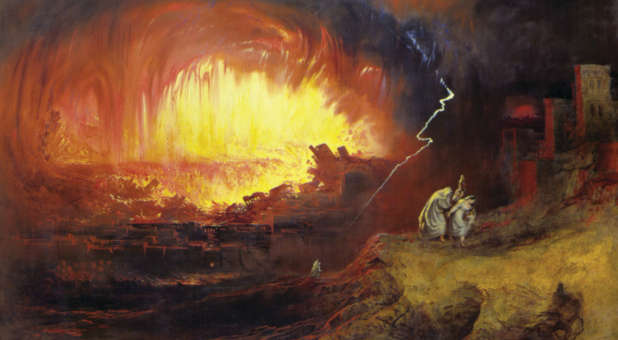Shocking Theory: Was Biblical Sin City Destroyed by Asteroid Stronger Than Nuke?
In a groundbreaking revelation that could attempt to rewrite history, theologian Dr. John Bergsma has put forth a theory that the ancient city of Sodom, infamous for being destroyed by God for its sinful inhabitants, met its fiery demise not by divine wrath alone but by the cataclysmic impact of an asteroid stronger than a nuclear weapon.
A distinguished scholar in biblical studies, Dr. Bergsma contends that excavations in Jordan provide compelling evidence for the authenticity of the biblical tale of the destruction of Sodom.
Archaeological findings in the southern Jordan Valley, particularly at Tell el-Hammam, point to a city that suffered a fate mirroring the biblical account. The once-thriving city that eclipsed the size and strength of Jerusalem and Jericho, seemed to vanish suddenly, without signs of a military siege. Instead, evidence of extreme heat on skeletons and pottery fragments suggests an extraordinary event occurred, possibly an asteroid impact, Bergsma contends.
The biblical narrative in the book of Genesis describes God’s punishment of Sodom and Gomorrah with a rain of brimstone and fire due to the grievous sins of the city’s people. Bergsma’s theory draws parallels between the archaeological discoveries and the biblical story, highlighting the intense heat experienced by the city’s residents.
Tell el-Hammam’s chief archaeologist, Steven Collins, shared some remarkable findings with Bergsma. Pottery shards coated with trinitite, a glassy substance formed during nuclear explosions, were uncovered, pointing to a catastrophic event. Moreover, human remains with skeletons intact up to the mid-spine, above which only scorch marks remained, indicate that a massive burst of heat from the sky engulfed the city, resembling the aftermath of an asteroid impact.
Collins likened the destruction of Sodom to the Tunguska event of 1908, an enormous asteroid impact that devastated the Siberian wilderness. He noted that the proposed airburst that obliterated Sodom would have been even larger than the Tunguska event, having 1,000 times more energy than the atomic bomb that devastated Hiroshima.
Intriguingly, the catastrophe also left behind significant quantities of salt, as noted by James Kent, an associate professor of earth sciences at the University of California. This peculiar detail may remind some of the story of Lot’s wife, who, according to the Bible, turned into a pillar of salt as she looked back upon the destruction of Sodom.
While discoveries made present a compelling case, some archaeologists remain cautious, accusing Collins of prematurely drawing conclusions without sufficient field evidence. The connection between the archaeological findings at Tell el-Hammam and the biblical narrative of Sodom’s destruction is intriguing.
The story of Sodom and its sister city, Gomorrah, has long captivated readers and scholars. It recounts the tale of Abraham’s negotiations with God to spare the sinful city of Sodom, which was filled with wicked inhabitants. God’s resolute response was to turn these cities into smoldering ruins, leaving behind nothing but desolation and smoke.
Dr. John Bergsma’s theory challenges conventional wisdom and biblical narrative. As excavations and research continue, the mystery of Sodom’s fate deepens, offering an intriguing glimpse into the intersection of history, archaeology and faith.
But the Word of God, as true Christians know, is inerrant, and many have tried to discredit that assertion over the centuries. {eoa}
Join Charisma Magazine Online to follow everything the Holy Spirit is doing around the world!
Shawn A. Akers is the online editor at Charisma Media.














































